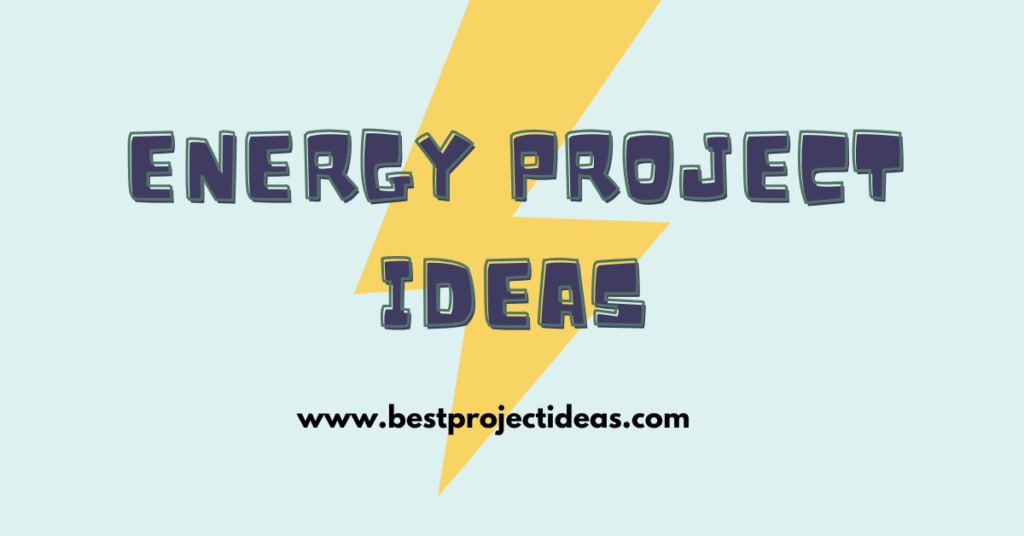
Energy projects help us learn how to use, store, and save power better.
They are fun to build, teach important science, and can even help the planet! Below is a simple guide to creating an energy project blog that’s clear and useful for students.
What Are Energy Project Ideas?
Energy project ideas are plans or experiments that explore different ways to generate, store, or conserve energy.
These projects can use solar panels, wind turbines, batteries, or smart devices to show how energy works and why it matters.
Why Are Energy Project Ideas So Important?
- Hands‑on Learning
- You see science in action.
- You understand real‑world energy problems.
- Environmental Impact
- Encourages use of clean power.
- Raises awareness about saving resources.
- Future Skills
- Builds skills in engineering and technology.
- Prepares you for green‑energy careers.
- Problem Solving
- Teaches you to design, test, and improve.
- Develops creativity and critical thinking.
Top 299+ Energy Project Ideas 2025-26
Solar power is clean, abundant, and perfect for hands‑on projects. These ideas explore panels, tracking, and novel uses of sunlight.
- Develop a small solar charger for smartphones.
- Build a solar-powered LED lamp.
- Design a portable solar cooker.
- Create a solar-powered water pump.
- Construct a solar-powered irrigation system.
- Prototype a solar tracker to maximize panel efficiency.
- Build a folding solar panel for backpacks.
- Design a solar-powered USB hub.
- Create a solar-powered weather station.
- Develop a solar-powered air purifier.
- Build a solar‑powered greenhouse controller.
- Design a solar-powered battery charger.
- Prototype a solar sidewalk light.
- Create a solar‑powered garden fountain.
- Build a solar roof vent fan.
- Design solar‑paint powered panels.
- Develop a solar‑powered Bluetooth speaker.
- Construct a solar-powered surveillance camera.
- Build a DIY solar water heater.
- Design a floating solar panel for ponds.
- Create a solar‑powered car ventilation system.
- Develop a solar-powered insect repellent device.
- Build a solar road stud for safety.
- Design a solar tree light installation.
- Prototype a wearable solar textile.
- Create a solar-powered e‑bike charger.
- Build a solar‑powered smart bench.
- Develop a solar-powered air conditioner prototype.
- Design a solar desalination unit.
- Create a solar-powered emergency radio.
More: Top 199+ Solar Project Ideas for Students 2024
Wind Energy Projects
Harness the power of wind with turbines, aerodynamics, and smart control systems to generate clean electricity.
Wind energy projects let you explore turbine design, blade optimization, and small‑scale generation for off‑grid or educational use.
- Build a small vertical-axis wind turbine.
- Design a horizontal-axis wind turbine model.
- Prototype a bladeless wind generator.
- Create a wind-powered water pump.
- Develop a smart wind turbine monitoring system.
- Build a DIY wind turbine from PVC.
- Design an automatic yaw control for turbines.
- Prototype wind turbine blade pitch control.
- Create a wind-powered streetlight.
- Develop a hybrid solar‑wind generator.
- Build a wind data acquisition system.
- Design a low-cut-in‑speed turbine.
- Prototype a foldable wind turbine.
- Create a household wind generator kit.
- Develop a wind turbine blade material study.
- Build a wind-powered workshop ventilation fan.
- Design a micro‑wind turbine for roofs.
- Prototype a wind turbine with wireless telemetry.
- Create a wind-powered charging station.
- Develop a vertical-axis turbine with open-source design.
- Build a homemade wind turbine anemometer.
- Design a noise-reduced turbine blade.
- Prototype a wind energy forecasting tool.
- Create a DIY wind turbine safety brake.
- Develop a wind farm layout optimization tool.
- Build a wind turbine maintenance robot.
- Design a low-cost turbine for rural areas.
- Prototype a kite-based wind generator.
- Create a wind-powered mobile phone charger.
- Develop a wind turbine icing prevention system.
Hydroelectric Energy Projects
Use flowing water for clean power. From micro‑hydro generators to water‑wheel experiments, there’s plenty to explore.
Hydroelectric projects can be scaled from desktop turbines to river installations, teaching fluid dynamics and power generation.
- Build a small water wheel generator.
- Design a micro‑hydropower turbine.
- Prototype a Pelton wheel model.
- Create a hydroelectric bottle generator.
- Develop a DIY hydroelectric dam simulator.
- Build a stream‑powered LED lantern.
- Design a Pico-hydro plant for home use.
- Prototype a floating hydro generator.
- Create a water‑powered battery charger.
- Develop a hydro turbine blade optimization study.
- Build a hydroelectric-powered fountain pump.
- Design a hydro-powered car battery charger.
- Prototype a river flow energy harvester.
- Create a hydroelectric-powered irrigation pump.
- Develop a fish-friendly turbine design.
- Build a tidal flow micro-generator.
- Design a wave energy generator.
- Prototype an underwater turbine sensor system.
- Create a hydro-powered smart buoy.
- Develop a hydroelectric efficiency monitoring tool.
- Build a micro dam for educational demo.
- Design a hydro-powered water quality monitor.
- Prototype a modular micro‑hydro kit.
- Create a runoff-powered streetlight.
- Develop a small-scale pumped storage model.
- Build a hydro generator with Arduino control.
- Design a HydroBot for maintenance tasks.
- Prototype a kinetic energy harvesting floor tile (water‑jet based).
- Create a rainwater-powered generator.
- Develop a DIY hydroelectric power station model.
Bioenergy Projects
Explore fuels from biomass, algae, and waste. These ideas cover biodiesel, biogas, and innovative biomass uses.
Bioenergy projects teach about chemical conversion, fermentation, and sustainable resource management.
- Build a home biogas digester.
- Design an algal biofuel reactor.
- Prototype a DIY biodiesel processor.
- Create a biomass gasification stove.
- Develop a methane capture system for farms.
- Build a compost-to-energy system.
- Design a waste‑to‑fuel experiment.
- Prototype a wood pellet stove.
- Create an algae-based biofuel scooter.
- Develop a microbial fuel cell.
- Build a biogas-powered cooking stove.
- Design a biochar production unit.
- Prototype a sugarcane bagasse boiler.
- Create a DIY ethanol distiller.
- Develop a waste paper-to-fuel system.
- Build a livestock waste anaerobic digester.
- Design a solar-assisted biodiesel reactor.
- Prototype a biomass briquette maker.
- Create an algae-powered generator.
- Develop a kitchen waste biogas plant.
- Build a coffee grounds biodiesel demonstration.
- Design a cellulose-degrading enzyme study.
- Prototype a plasticized biomass furnace.
- Create a biogas-powered fridge model.
- Develop a straw-to-electricity system.
- Build a sugar fermentation energy demo.
- Design a food waste pyrolysis unit.
- Prototype a bioenergy-powered greenhouse.
- Create an algae oil extraction kit.
- Develop a home-scale charcoal gasifier.
Geothermal Energy Projects
Tap into Earth’s heat for power and heating. Projects include heat pumps, thermal probes, and Earth‑tube systems.
Geothermal ideas teach geology, thermodynamics, and renewable heating technologies.
- Build a small geothermal heat pump.
- Design a DIY ground-source heat exchanger.
- Prototype an Earth‑tube ventilation system.
- Create a geothermal greenhouse heater.
- Develop a borehole temperature monitor.
- Build a geothermal-powered water heater.
- Design a soil thermal conductivity experiment.
- Prototype a passive Earth-sheltered home model.
- Create a geothermal cooling demo.
- Develop a thermal probe calibration tool.
- Build a closed‑loop ground heat exchanger.
- Design an open‑loop geothermal system.
- Prototype a hybrid solar‑geothermal heater.
- Create a heat exchanger with waste heat.
- Develop a DIY hot water radiator system.
- Build a tile-based geothermal floor heating.
- Design a geothermal reservoir simulation.
- Prototype a geothermal energy storage model.
- Create a smart geothermal control unit.
- Develop a deep Earth temperature mapping project.
- Build a geothermal heat recovery ventilator.
- Design a small-scale flash steam plant.
- Prototype a binary cycle geothermal generator.
- Create a waste heat geothermal charger.
- Develop a geothermal performance monitoring dashboard.
- Build a geothermal coil installation demo.
- Design a thermal battery using geothermal heat.
- Prototype a reversible geothermal air conditioner.
- Create a soil-based energy storage system.
- Develop a geothermal-powered fish pond heater.
Energy Storage Projects
Storing energy is key to renewables. Ideas include batteries, supercapacitors, and thermal storage.
Storage projects teach electrochemistry, materials science, and system integration.
- Build a lead‑acid battery pack.
- Design a Li‑ion battery management system.
- Prototype a supercapacitor bank.
- Create a thermal energy storage tank.
- Develop a flywheel energy storage model.
- Build a DIY redox flow battery.
- Design a sodium‑ion battery prototype.
- Prototype a graphene‑supercapacitor.
- Create a phase-change material heater.
- Develop a pumped thermal storage demo.
- Build a zinc-air battery model.
- Design a battery health monitoring tool.
- Prototype a paper-based battery.
- Create a home solar battery bank.
- Develop a Tesla Powerwall‑style system.
- Build a saltwater battery.
- Design a battery thermal management unit.
- Prototype a smart energy storage controller.
- Create a kinetic energy storage device.
- Develop a hydrogen storage tank model.
- Build a NaS battery demo.
- Design a battery safety shutdown circuit.
- Prototype a ceramic battery cell.
- Create a DIY ultracapacitor from coins.
- Develop a thermal storage using rocks.
- Build a home ice battery for cooling.
- Design a compressed air energy storage kit.
- Prototype a gravity energy storage tower.
- Create a battery swap station model.
- Develop a hybrid battery-supercapacitor system.
Energy Efficiency Projects
Reduce energy use with smart design. Projects range from insulation tests to smart lighting and appliance control.
Efficiency projects teach building science, electronics, and behavioral change.
- Test different insulation materials in walls.
- Design a smart thermostat with Arduino.
- Prototype a motion‑sensor LED strip.
- Create a solar attic fan.
- Develop a window heat-loss monitor.
- Build an energy‑saving power strip.
- Design a smart blind control for daylighting.
- Prototype a occupancy-based HVAC control.
- Create a fridge door‑open alert system.
- Develop a home energy usage dashboard.
- Build a DIY low-energy lighting retrofit.
- Design a smart plug energy logger.
- Prototype a night‑time streetlight dimming system.
- Create an energy-efficient water heater controller.
- Develop a smart window insulation film.
- Build an RFID-based appliance shutdown.
- Design a home energy auditing robot.
- Prototype a solar reflective roof coating test.
- Create a smart occupancy sensor for lights.
- Develop a home energy prediction AI model.
- Build a waste-heat recovery vent.
- Design a smart charging schedule for EVs.
- Prototype a daylight harvesting system.
- Create a DIY double‑glazed window demo.
- Develop a thermal imaging energy audit tool.
- Build a low-flow showerhead with feedback.
- Design a heat‑recovery ventilation unit.
- Prototype a smart laundry timer.
- Create an energy-aware home assistant skill.
- Develop a home appliance efficiency comparison app.
Smart Grid & IoT Projects
Connect devices and power systems for smart management. Ideas cover sensors, communication, and data.
Smart grid projects teach networking, control systems, and data analytics in energy.
- Build an IoT-based solar monitoring system.
- Design a smart meter with Raspberry Pi.
- Prototype a demand‑response controller.
- Create a blockchain energy trading demo.
- Develop a microgrid management dashboard.
- Build a wireless power meter network.
- Design a secure grid communication protocol.
- Prototype a grid frequency stabilizer.
- Create a smart streetlight network.
- Develop an energy theft detection system.
- Build a predictive maintenance for transformers.
- Design a virtual power plant platform.
- Prototype a real‑time grid load balancer.
- Create an IoT-based home solar inverter.
- Develop a smart EV charging station.
- Build a distributed energy resource controller.
- Design a peer-to-peer energy marketplace.
- Prototype a grid anomaly detection AI.
- Create a smart capacitor bank controller.
- Develop a synchronized grid clock system.
- Build a wireless sensor network for lines.
- Design a demand forecasting AI model.
- Prototype a blockchain microgrid.
- Create an IoT-enabled battery storage.
- Develop a smart demand-side management tool.
- Build a grid-connected energy router.
- Design a solar‑wind hybrid controller.
- Prototype an automated grid fault reporter.
- Create a home energy gamification app.
- Develop a dynamic tariff display device.
Transportation Energy Projects
Focus on low‑carbon transport: EVs, fuel cells, and hybrid systems, plus testing and simulation.
Transportation energy teaches propulsion, batteries, and clean fuels for mobility.
- Convert a bicycle to electric power.
- Design a DIY fuel-cell car model.
- Prototype a solar-powered go-kart.
- Create a supercapacitor-powered scooter.
- Develop a regenerative braking demo.
- Build a home EV charger.
- Design a hydrogen fuel station model.
- Prototype a hybrid electric boat.
- Create a wireless EV charging pad.
- Develop a biofuel-powered RC car.
- Build a pneumatic vehicle suspension for efficiency.
- Design an aerodynamic car cover.
- Prototype a solar-powered drone.
- Create a smart EV route planner.
- Develop an energy‑harvesting bumper system.
- Build a DIY hydrogen electrolyzer for cars.
- Design a vehicle energy usage monitor.
- Prototype a lightweight composite car panel.
- Create a solar canopy carport charging station.
- Develop an AI-based eco-driving coach.
- Build a kinetic energy recovery system for bikes.
- Design a plug-in hybrid conversion kit.
- Prototype a solar-assisted train model.
- Create a waste‑heat recovery for trucks.
- Develop a hydrogen‑methanol dual‑fuel engine.
- Build a solar‑powered charging station map app.
- Design an EV battery second‑life system.
- Prototype a wireless bike light charger.
- Create a smart traffic lights energy saver.
- Develop a lightweight battery pack module.
Innovative & Miscellaneous
For creative and cross‑disciplinary ideas: from futuristic concepts to energy art installations.
This category captures cutting‑edge, out‑of‑the‑box energy ideas to spark innovation.
- Design an energy-harvesting dance floor.
- Prototype a triboelectric shoe sole.
- Create a piezoelectric road tile.
- Develop an energy-generating playground.
- Build a microbial fuel pavement.
- Design an energy‑producing art installation.
- Prototype a smart mirror that harvests light.
- Create a kinetic chandelier.
- Develop a self‑charging smartwatch band.
- Build a lightning energy harvester model.
- Design a thermoelectric backpack.
- Prototype a body-heat-powered wearable.
- Create a solar-powered billboard.
- Develop a salt gradient power generator.
- Build a DIY ocean thermal energy converter.
- Design a hybrid piezo-solar bench.
- Prototype a wind-and-solar street umbrella.
- Create a self‑powered smart lock.
- Develop a vibrating-window energy harvester.
- Build a salt-to-electricity prototype.
- Design a tidal kite generator.
- Prototype a floating energy island model.
- Create an energy-harvesting umbrella.
- Develop a glow‑in‑the‑dark pavement that stores solar light.
- Build a hydrogen-from-plastic pyrolysis demo.
- Design a self‑cleaning solar panel system.
- Prototype a smart shoes that charge phones.
- Create an energy-harvesting door mat.
- Develop a spray‑on photovoltaic coating test.
- Build a wireless power-transmitting table.
Also Read: 247+ Unique Inspire Award Project Ideas For Science Students
How to Develop Energy Project Ideas
- Pick an Energy Type
- Solar, wind, hydro, or biomass.
- Define Your Goal
- Generate power, store power, or save power.
- Brainstorm Experiments
- Sketch simple designs.
- List required materials.
- Research & Plan
- Read articles or watch tutorials.
- Write down step‑by‑step instructions.
- Build & Test
- Gather materials safely.
- Measure results and note challenges.
- Improve & Share
- Tweak your setup for better results.
- Present your findings in a report or video.
Benefits of Doing an Energy Project
- Deep Understanding of how energy systems work.
- Teamwork Skills when you collaborate with friends.
- Innovation by creating new or improved devices.
- Confidence Boost from completing a hands‑on build.
- Environmental Awareness grows when you see impacts firsthand.
Tips for Choosing the Best Energy Project
- Match Your Interest: Love the sun? Pick a solar project!
- Check Materials: Use things you can easily find or reuse.
- Skill Level: Start simple if you’re new; go advanced if you have experience.
- Budget: Keep costs in mind—many projects can use recycled parts.
- Time Frame: Estimate how long each step will take.
Steps to Plan and Execute Your Energy Project
- Research Background: Understand theory and past projects.
- Gather Materials: List and collect everything you need.
- Design & Sketch: Create clear drawings or diagrams.
- Build Prototype: Assemble your device step by step.
- Test & Measure: Record data (voltage, current, temperature).
- Analyze Results: Graph your data and look for trends.
- Optimize: Make changes to improve performance.
- Present Findings: Write a report or create a poster/video.
Additional Heading: Safety and Sustainability
- Safety First: Wear goggles, gloves, and follow electrical safety.
- Eco‑Friendly Materials: Reuse old devices and recycle parts.
- Disposal Plan: Properly dispose of batteries and chemicals.
Conclusion
Energy projects are a great way to learn science, help the planet, and build skills for the future.
With the right idea, clear plan, and safety in mind, you’ll create a project you can be proud of.
Ready to light up your world? Choose your favorite idea and start experimenting today!

